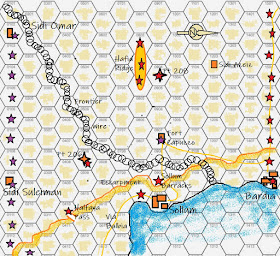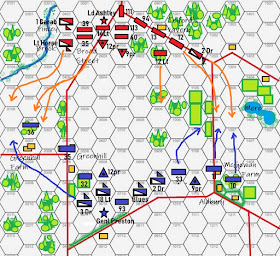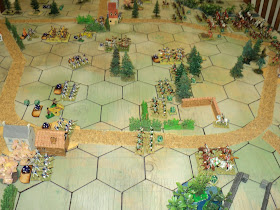On the morning of 15 June, 1941, the long awaited and eagerly anticipated Operation Battleaxe rolled into motion. Eleventh Indian Brigade and 4th Royal Tank Regiment (RTR) advanced along the escarpment toward the vital Halfaya Pass, defended by 7th Bersagliere backed by anti-tank guns. Also under 4th Indian Division command, the Guards Brigade, accompanied by 7th RTR, pushed on towards Point 206, overlooking the frontier wire.
 Unfortunately a staff error (for which no satisfactory explanation was ever forthcoming, apart from the inability, twice demonstrated, of a certain general staff officer to count up to three) led to the Buffs and 2 Queen's Own Cameron Highlanders failing to appear on the start lines. The absence of one third of the infantry rather compromised Eighth Army's chances of success in this operation (and rather discouraged the writing of this After Action Report, truth be told). But it was a fairly involving battle all the same, and it was only when starting to write this article that I discovered the 'General Staff's' snafu.
Unfortunately a staff error (for which no satisfactory explanation was ever forthcoming, apart from the inability, twice demonstrated, of a certain general staff officer to count up to three) led to the Buffs and 2 Queen's Own Cameron Highlanders failing to appear on the start lines. The absence of one third of the infantry rather compromised Eighth Army's chances of success in this operation (and rather discouraged the writing of this After Action Report, truth be told). But it was a fairly involving battle all the same, and it was only when starting to write this article that I discovered the 'General Staff's' snafu.Priority being given to the capture of Halfaya Pass, the Indian infantry attacked from above (Mahratta) and below (Rajputana) the escarpment, led by the Central India Horse (CIH) armoured cars to spy out the defenders, and the Scots Guards and 4th Royal Tanks advancing on the left of the Indian infantry. Supporting this attack was half the Division's artillery.
The attack upon Pt 206 was left to the Coldstream Guards and 7th Royal Tanks, supported by the balance of the Div Artillery. (Just as an aside, here, to give the recon units a role, I enacted that the first attack against enemy in 'D' (Defence) mode required double-5 or double-6 to score hits, but subsequent attacks required only a '6'. Nippy little recon units being capable of rapid movement to get themselves out of trouble, could afford to take the loss without being destroyed, even at the loss of all their strength points (SPs). This allowed the troops with more heft a better chance of doing some damage before the erosion of their own strength became too severe). According to this scheme, the CIH took its lumps and vanished behind the advancing troops. Not that it availed much: three infantry battalions, a tank regiment and a regiment of artillery battered the Halfaya Pass position, and although what remained of the anti-tank units had to pull out, the Bersagliere seemed disinclined to follow.
The much lighter attack on Pt206 seemed to promise better success, although 7th Royal Tanks also took heavy losses.
Meanwhile, the 7th Armoured Brigade and its support group, led by the 11th Hussars, crossed the Frontier Wire without opposition and advanced rapidly towards Hafid Ridge, the capture of which feature was deemed vital to the success of the Operation. The position was held by a panzergrenadier battalion, a reconnaissance unit, a detachment of 8.8cm FlaK guns in anti-tank role, and a battalion from 8th Panzer Regiment. As the main body of the British formation drove north, they left a screen of 2-pounder anti-tank guns not far distant due west of Point 206, by way of a link, or liaison, between the two wings of the Allied push.

The first real Allied success came from the extreme left of the line, with the King's Royal Rifle Corps (KRRC) and the Rifle 'Brigade' forcing 33rd Recon Unit off the western end of Hafid Ridge. Following up this success, the infantry, with support from 2nd Royal Tanks rolled up half the remainder of the ridge, leaving the '88s' clinging precariously to the eastern end. Meanwhile, 6th Royal Tanks swung to the right, where a counter-attack by the panzers and gepanzert infantry seemed to be developing, a few miles north of Pt 206. The I/8th Panzer that had begun the day on Pt 208 had dropped to the desert floor to join its sister battalion for a united blow.
By mid-afternoon, the attack on Halfaya had been repulsed, and 11th Brigade was back on its start line. The assault on Pt 206 was still ongoing, but barely.
Aware that the defenders were as much exhausted as they themselves were, the Coldstream Guards made one final effort late in the afternoon that swept the panzergrenadiers off the feature, whence they fell back along the Wire towards Sollum..
As night drew in, Eighth Army had cleared Pt 206 and most of Hafid Ridge. But Afrika Korps retained the hold of the rest of the eminence, and, more importantly, the Italians were still in possession of Halfaya Pass.
Of course, the action was to continue through to the second day. In common with the usual 8th Army practice, the units in contact (i.e. in adjacent grid areas) fell back to laager overnight. The Axis troops were allowed to remain 'in situ'. Both sides could replenish SP losses at a rate of 50% overall, and 50% by type, halves rounded up or down in accordance with the overall total rounded up once only. Destroyed units were not counted in the restoration.
Eighth Army lost 33SP overall: 7 tanks, 22 infantry, 4 reconnaissance, though 2 of the latter (11 Hussars) counted as destroyed when struck by enemy armour after having been reduced to 0SP. They recovered 4 tank, 11 infantry and 1 recon SP overnight. Not having the Axis figures (I think they lost about 16SP all up during the day), I can not comment upon their recovery, but it did mean that as far as Halfaya Pass was concerned, it would be all to do again on the morrow.
Worse news was the arrival of elements of Afrika Korps's 5th Light Division, a long column travelling along the Via Balbia towards Bardia. Lt-Genl Cruewell ordered this formation to leave the road, and counterattack on the line west of the Hafid Ridge, where the battle was once again raging.
Seventh Armoured Division had there seized the initiative (low sequence numbers) and attempted to take that part of Hafid Ridge they had captured the day before. In this they were less successful. True, they overran some of the high ground once more, but were unable to sustain themselves there, and KRRC found themselves perforce driven off with heavy losses and forced back towards the wire.
German counter-attacks developed soon from the east end of Hafid, from a battalion each of panzers and gepanzert infantry. Within a few hours, 5th Light Division was to join in the attacks.

A somewhat revitalised 4th Indian Division began its assault upon Halfaya Pass, bringing in all the resources that could be brought to bear, save 3rd Coldstream Guards occupying Pt 206. That stout battalion had to be left to its own devices, though, as it turned out, they were not seriously attacked throughout the day. By this concerted effort, the Bersagliere were gradually levered out of their dug in positions, and fell back towards the Sollum-Fort Capuzzo line. It was an exiguous Indian Brigade that occupied the hard-won Pass.
 That was to be Eighth Army's sole achievement of the day.
That was to be Eighth Army's sole achievement of the day.At this point 'Jacko' (Paul Jackson, playing the Axis role) had to leave for a mid-afternoon commitment. Although it was fairly plain already that 8th Army had achieved all it was going to achieve, there was still two-thirds of the second day remaining. I decided to play it out solo.
Seventh Armoured were not long left in suspense. DAK recon elements soon discovered the British defence line, whereat 5th Light attacked from the north, with 15th Panzer Div infantry joining in supported by their artillery. The 15th Div panzers carried out, meanwhile, a direct attack upon the 2-pounder portee gun line - a costly charge as it turned out. Barely half the panzers survived to overrun the guns, but overrun them, they did.
The real denouement was being enacted some five to ten miles to the west. Fifth Light Division developed an attack against the flank of the 7th Armoured Division line, whilst the panzergrenadiers of 15th Panzer Division attacked the centre, where 2nd Battalion, Rifle Brigade occupied a shallow salient.
 The King's Royal Rifle Corps was soon overrun by tanks, after which a considerable battle raged all over the desert floor between Hafid Ridge and the Wire. Almost from the start, the British defences began to crumble, though the Germans were taking heavy losses as well. As the late afternoon light began to fade, the Rifle Brigade was in turn driven in. The rest of 7th Armoured - what remained of the tanks and the artillery - gave up the struggle and retreated, back over the Wire.....
The King's Royal Rifle Corps was soon overrun by tanks, after which a considerable battle raged all over the desert floor between Hafid Ridge and the Wire. Almost from the start, the British defences began to crumble, though the Germans were taking heavy losses as well. As the late afternoon light began to fade, the Rifle Brigade was in turn driven in. The rest of 7th Armoured - what remained of the tanks and the artillery - gave up the struggle and retreated, back over the Wire.....
There ended the two-day Operation Battleaxe battle. Its only successes were the capture of Point 206, and carrying of the Halfaya Pass position - though they were sufficient for Lt-Gen Beresford-Pierse to claim a victory. If victory it was, it cost a great deal in manpower and equipment, especially armour.
Unfortunately, my own cock-up with the missing battalions deprived this action of much of its interest. It must have been a much closer thing had they been present. In the real operation, the Guards Brigade carried Fort Capuzzo. That was never going to happen in this action. For all that, it remained an involving battle as it stood. This has to be on the 'Must Redo' list.




































































